Bathroom handrails: varieties and choices

Today, special handrails for bathrooms are gaining more and more popularity. They are able to provide quality support during the adoption of water procedures, and can also look great in different style solutions. In this article, you will get acquainted with the varieties of bathroom handrails, as well as with the features of their selection and installation.
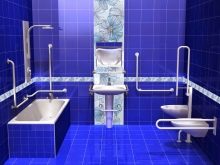

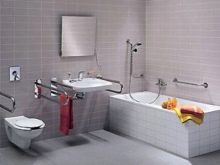
Appointment
Depending on the variety, as well as its placement in the bathroom, handrails can serve several functions.
- Support when using the toilet or bath. Typically, support devices are installed in apartments where pregnant women, the elderly or people with disabilities live. Quality handrails provide additional support when leaving the bathroom or moving from a toilet seat to a wheelchair. These designs allow you to exclude outside help and fully use the bathroom on their own.
- Prevention of involuntary sliding. The bathroom is a place with high humidity, where condensation constantly forms on the floor and walls. People with poor motor skills, injuries to the arms or legs, and vestibular disorders can be seriously injured by making one inadvertent movement. The handrails allow you to move safely within the bathroom and hedge against involuntary slips.
- Decorative. Some modern owners are creative about the forced installation of support fixtures in the bathroom. In such bathrooms, handrails become a full-fledged decorative item and are able to harmonize with the chosen style solution in the bathroom.



Views
Experts distinguish only 2 classifications of handrails for bathrooms.
According to the first classification, all supporting structures can be divided according to the material from which they are made: metal, polyurethane, reinforced plastic or wood. Each of these materials has its own characteristics, pros and cons.
- Metal. Typically, metal handrails are made from stainless steel or bronze, copper and brass. Models made of stainless steel are considered the most durable - they serve for a very long time, have excellent indicators of rigidity, and can also be made in completely different interpretations. Variants from non-ferrous metals and alloys are much less common. They will cost a lot more, need extra care and are generally used to complement a particular style in a room.
All metal handrails, due to their high weight, need reliable fastening. It should be remembered that any metal support structures without chrome plating deteriorate very quickly from moisture.



- Polyurethane. Considered a cheaper replacement for metal models. Constructions made of this material are lightweight, pleasant to the touch and very quickly assembled in a new place thanks to vacuum suction cups. Unfortunately, the polyurethane models are very light-weighted and are only suitable as belay models for infrequent use.


- Reinforced plastic. Reinforced plastic models are the cheapest among the rest of the handrails. They can be made in any color and design, they are quickly installed and fastened using any fasteners, but they have too little rigidity. On average, such products last no longer than 2 years and often break when used in extreme conditions (with sharp and fast sliding).


- Wood. Despite the fact that wooden structures are environmentally friendly and can effectively complement the design of a room, they are rarely used in bathrooms. Everything is explained by the too poor resistance of this material to high levels of humidity. To preserve wooden handrails for a longer period, special moisture-repellent solutions are used.


In addition to this classification, all bathroom handrails can be divided according to the method of attachment and installation characteristics. Here experts distinguish between folding (or swivel), stationary (wall), vacuum (suction cups), and steps with handrails.
- Folding. These types of bathroom handrails are fixed with screws and hinges, which allows them to be freely operated without wasting space. The main requirement for such structures is reliable installation, which should be carried out exclusively on a load-bearing wall. Typically, such structures are a metal base with a folding mechanism that can be folded back and fixed in several directions at once.


- Stationary... Structures of this type include all handrails of the railing type, which are rigidly mounted on load-bearing walls near the bathroom or toilet. These tubular structures can be curved, straight, vertical or oblique. It is safer and most convenient to choose straight structures - they are easy to use, easy to attach and usually do not lead to slipping of the hands.


- Vacuum handrails... The advantage of such supporting structures is that additional mounting elements are not required for their fastening. They are most efficiently mounted on tiles or plasterboard panels. In addition, some of these models are equipped with special indicators that indicate the degree of adhesion to the wall surface.
Unfortunately, such handrails can effectively serve only as an additional support, since they usually can withstand up to 50-60 kg of load (in rare cases, up to 80).

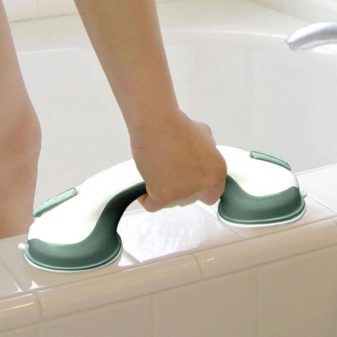
- Steps with handrails. Typically, such designs are purchased for children or people with disabilities. It is a full metal structure with one to three steps and a vertical metal frame to support the arms. These structures can be installed in front of a tall hot tub. The disadvantage of these units is their size and poor ergonomics: they are only suitable for spacious bathrooms with a lot of free space.
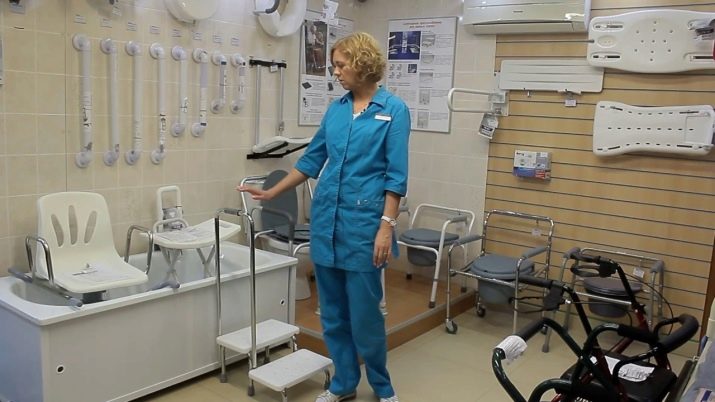
How to choose?
Today manufacturers offer a huge number of different models of bathroom handrails. However, regardless of the type and purpose of such structures, they must meet certain requirements for rigidity, reliability and convenience. When choosing bathroom supports, pay attention to the recommendations below.
- Bathroom dimensions. The dimensions of the supporting structure should be chosen depending on the dimensions of the bathroom itself, as well as the elements near which the handrails will be installed. If these are handrails specifically for a bath, determine the dimensions of the font, as well as the height at which the structure will be most conveniently used. The type of handrail also depends on the amount of free space in the bathroom - in large and spacious bathrooms, you can choose stationary models or steps with handrails; for smaller bathrooms, devices with a folding handle or portable handrails with Velcro are suitable.
- Load. When choosing a handrail, the load on the handrail should be calculated from the heaviest person using the bathroom. For example, handrails with suction cups can withstand a load of up to 80 kg, and stationary models with a reliable fastening - up to 150. Anyway, you should not rest your whole body on any handrails - they serve for support, not for holding.
- Material... The material for the manufacture of supports must be not only strong, but also hygienic, and also not subject to corrosion - which is why metal models of supports may not be suitable here. Corrosion can weaken fasteners and can cause serious injury. Regardless of the material chosen, buy models of handrails with rubberized handles or anti-slip coating - this way you protect yourself and your loved ones from accidental injuries.
- Unit dimensions. Choose models that are thick enough for you to wrap your hand around them comfortably. Here you should consider the size of the palms of all members of your family. Typically, for bathrooms, handrails are selected with a diameter of no more than 5 cm and a length of up to 60 cm.
- Contrast. If the handrail is already chosen for an elderly person with poor eyesight, it is better to buy models that will be clearly visible against the background of the wall or other elements of the room.
- Equipment... The set for the handrail should also include its fastening elements. If it comes to stationary models, in addition to the handrail, in the package you should find anchors, plugs, dowels, brackets, crosses or any other elements for fastening.
- Functionality. Modern bathroom handrails can be additionally equipped with elements that facilitate the use of bathroom accessories. These can be soap dishes built into the outside of the pipes or towel hooks.

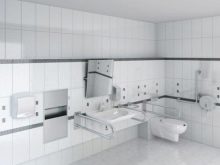

When choosing a handrail, remember that you are buying first of all a strong and safe model, and only then a beautiful model. Between a device with a beautiful design and a functional handrail that can support up to 130 kg, you should choose the second one.
How to arrange?
Depending on the purpose and type of handrails, they can be installed in several places in the bathroom.
The most common attachment points are the sides of the bathroom, as well as the load-bearing wall next to it. Such structures allow you to safely climb and insure a person from accidental slides along the bottom of the font.These designs can be useful for both children and the elderly.
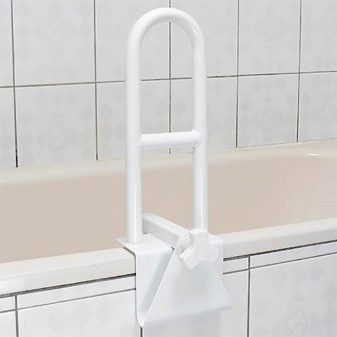

Another popular handrail attachment point is the wall near the shower or near the hot tub.
In this place, it is designed to support a person and insure him from falling onto a slippery floor surface.


Another place for attaching handrails is used in apartments where people with disabilities live.
As a rule, these are stationary tubular metal handrails designed to support while moving from a toilet seat to a wheelchair or wheelchair.
In the case of supporting structures for bathrooms, it is important not only to correctly select a suitable and convenient model, but also to correctly assemble it for convenient and safe use. Below you can find the general rules for installing bathroom handrails, as well as detailed instructions for attaching handrails with suction cups.

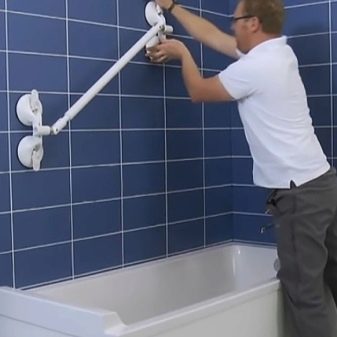
General rules for fastening support handrails.
- Before installing the handrail, determine the exact number of support structures, as well as the elements that will be used to mount the support structure. Pre-mark the locations where holes will be drilled and fasteners installed.
- If you want to mount the handrails directly on the side of the font, this procedure should be carried out before installing the font itself and redecorating in the bathroom. This will greatly simplify the task and provide full access for installation.
- When installing handrails that require secure anchorage with drilled walls, select an installation location that does not have wiring or water supply pipes. Such communications can be detected using special devices.
- If the handrail kit does not include fasteners, purchase them based on the recommended fastening type for your type of support structure and the maximum load the handrails will put on.
- Horizontal and straight models of handrails should be mounted on the wall where there is no sink or faucet. A distance of at least 10 cm should be maintained between the side of the bathroom and the structure, but do not forget to focus on your height and the growth of your household.
- If you have chosen a vertical straight structure, then it should be installed above the tap at least 20 cm from the side (from the bottom).
- When choosing horizontal inclined structures, the upper part of the handrail is fixed at a height of 20-24 cm from the side (from the side of the crane), and the lower part - at 2-5 cm.
- If you have a shower cabin at your disposal, then several handrails of different shapes and lengths are usually chosen for it, which are mounted in different places. If the bathing structure is equipped with a special seat, the handrails should be placed at a height of at least 20 cm from the edge of the font, while a handrail should also be installed on the opposite side of the seat.
- When mounting stationary models, you will need a pen to mark the drilling points, masking tape to prevent damage to tiles, an electric drill, a special drill for tiles or for wooden surfaces (it all depends on the material of the walls in your bathroom), a screwdriver, as well as screws and dowels (or more powerful fasteners).
- After any work involving drilling the walls in the bathroom, be sure to treat the joints near the holes with silicone sealant. This will prevent moisture from reaching the mounting parts.

Below will be described detailed instructions for the installation of handrails with vacuum suction cups - it is the most common type of support structure, which is installed in families with children and retirees.
- Before proceeding with the installation of the handrail, thoroughly clean, wipe and dry the surface on which the device will be mounted.Some manufacturers also require the walls to be degreased using special solutions.
- Each model of a handrail with suction cups should be equipped with special levers (usually two) located at each end of the handle. Select a location to attach the support, then press it firmly against the wall and lower the levers until they click into place.
- After that, the reliability of the structure needs to be checked several times - for this, it is enough to simulate the classic ascent from a slippery and water-filled font.
- If you want to remove the structure or change the place of its attachment, simply press the levers in the indicated place - after that, the structure should immediately detach from the wall, on which after that no traces remain.
An important point! It is not recommended to install suction cups on any irregular or rough surfaces. This includes wallpaper, plaster, or rough stone.

Examples of
Young apartment owners doubt the installation of support structures - the main reason for such fluctuations is the dubious attractiveness of such structures and their relevance against the background of other furniture or plumbing. Below you will find stylish and successful examples of using different types of handrails in bathrooms.
- Pay attention to how the metal and chrome handrails are harmoniously combined with the chosen style solution.


- Steps with handrails can be installed not only for practical, but also decorative purposes, as the following photos prove.


- Many people use handrails not only as a support, but also as a functional place to hold towels, magazines, toilet paper or bathroom utensils.


See below for an overview of one of the handrail models.








